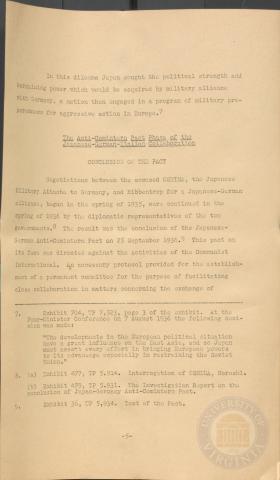
Page 5
| Parent | Japanese - German - Italian Collaboration |
|---|---|
| Date | |
| Language | English |
| Collection | Tavenner Papers & IMTFE Official Records |
| Box | Box 14 |
| Folder | Japan, Germany, Italy Collaboration and Introduction |
| Repository | University of Virginia Law Library |
In this dilemma Japan sought the political strength and bargaining pov/er which would be acquired by military alliance with Germany, a nation then engaged in a program of military pre¬paredness for aggressive action in Europe.7
The Anti-Comintern Pact Phase of the Japanese-German-Italian Collaboration
CONCLUSION OF THE PACT
Negotiations between the accused 0SHIMA, the Japanese Military Attache to Germany, and Ribbentrop for a Japanese-German alliance, begun in the spring of 1935, we re continued in the spring of 1936 by the diplomatic representatives of the two governments,® The result was the conclusion of the Japanese- German Anti-Comintern Pact on 25 September 1936.9 This pact on its face was directed against the activities of the Communist International. An accessory protocol provided for the establish-ment of a permanent committee for the purpose of facilitating close collaboration in matters concerning the exchange of
7.Exhibit 704, TP 7,523, page 3 of the exhibit. At the Four-Minister Conference on 7 August 1936 the following deci¬sion was made s
"The developments in the European political situation have a great influence on the East Asia, and so Japan must assert every effort in bringing European powers to its advantage especially in restraining the Soviet Union."
8.(a) Exhibit 477 ? TP 5.914. Interrogation of OSHIMA, Horoshi*
(b) Exhibit 479? TP 5.931. The Investigation Report on the conclusion of Japan-Germany Anti-Comintern Pact.
9.Exhibit 36, TP 5,934- Text of the Fact.
